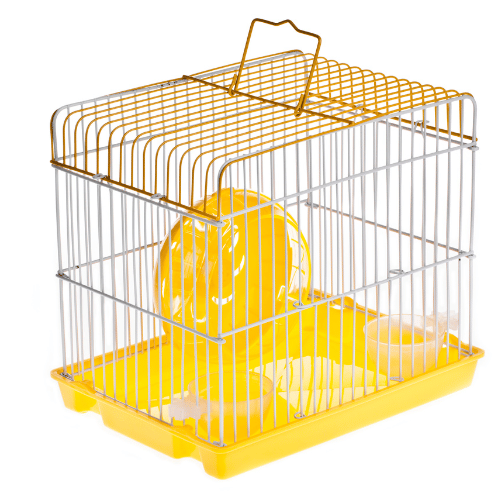You should purchase a suitable cage for a hamster before getting this beautiful pet. For hamsters, a high-quality, sufficiently-sized cage is essential. However, only a few hamster cages that may be obtained in pet shops are adequate for housing hamsters. So, let us discuss all about the minimum cage size for a hamster.
Hamster owners recommend a minimum cage size of 450 square inches. If possible, purchase a larger cage for your hamster and set it up well to create a rich habitat. When picking a hamster cage size, consider the type of hamster, cleaning, and ventilation.

We’ll explain some important points to help you choose the right hamster cage.
Importance of Cage Size for Your Hamster
There are many reasons why you must ensure that your hammy has a sufficient amount of living area. When maintained in a small cage, these creatures might develop acute anxiety, affecting their well-being.
A hammy without enough cage room will be disruptive and irritating. This involves persistently attempting to escape their cage and gnawing on the wires of their enclosure. Choose a cage with adequate area to keep your hammy healthy.
<strong>Do Hamsters Sleep With Their Eyes Open?</strong>
Hamster Cage (Size & Material)
There will always be limitations on an animal’s territory and freedom of movement when it is kept as a caged pet. This does not imply that hamsters cannot be housed in cages. It does mean that hamsters should not be housed in a cage that is too tiny.

As a responsible and loving owner, you should purchase an appropriate hamster cage for your pet.
Optimal Hamster Enclosure Size
Minimum hamster cage dimensions are 18 inches by 13 inches x 25 inches, or 440-460 square inches. Depending on your hamster, you must purchase a bigger cage. If you place your hammy in a significantly smaller cage, it will get extremely nervous and anxious.
Why is my Hamster Aggressive & What Can I do About it?
Hamster Cage Sizes by Sub-Types
There are many types of hamsters, and some demand a more spacious habitat than others. Before settling on a specific enclosure for your pet hammy, you will need to give this some thought. So, let us discuss space requirements for different hamster species.
- Syrian Hamsters: 600 square feet
- Dwarf Hamsters: 450 square feet.
- Chinese Hamsters: 500 square feet in size
Types of Cages
Now that you know the size choose a cage for your hamster. Hamsters may be kept in a number of different cages, each of which presents its own set of advantages and disadvantages. Most crucial are cage material, airflow, cleaning ease, and substrate compatibility.
- Wire Cage: Hamsters are typically housed in cages made of wire or mesh since these materials are readily accessible and easy to clean. They are an excellent choice since they cannot be chewed on, have enough ventilation, and are simple and quick to clean. The disadvantage of most of these variants is that they are not deep enough to accommodate the necessary quantity of substrate, which means that your hamster will not be able to burrow. In addition, the substrate and bedding tend to be forced out of the wire sides, resulting in a messy situation.
- Tank and Wire Cage: These setups are most likely the best choice for housing hamsters. It includes a plastic and glass tank base with a burrowing area and a clip-on wire or mesh top. The fact that they are adequately ventilated, simple to maintain, and reasonably escape-proof gives them the finest qualities of all possible housing options.
- Vivarium or Aquarium: Aquariums aren’t meant for hamsters but can work. They’re made of glass with a mesh top so your hamster can burrow freely. Even with the mesh top, these tanks have minimal airflow, which is a major drawback. Additionally, they are heavy, which makes it difficult to shift and clean them.

Hamster Cage Examples
Here is a selection of excellent cages that are immediately available.
Niteangel Glass Tank for Hamsters
If you’re searching for a tank-style cage, hamster owners strongly recommend this one. With dimensions of 36 inches by 18 inches, this cage provides your hamster with 648 square feet of floor area. This offers a large amount of space for the hamster to burrow, play, and enjoy a wide selection of hamster toys.
Prevue Pet Products 528 Small Pets Cage
This enclosure is 32.5 inches in length and 19 inches in width, and it has a combined floor space of almost 600 square inches that is split between two levels. The second floor is low enough that even a clumsy hamster may use it safely.
Cost of a Large Hamster Cage
You may expect to invest between $80 and $350 for an excellent hamster cage with significant space. Wire cages are typically more affordable than glass tanks for housing animals. That’s a big investment, but an animal lover should be delighted to spend for the pet’s health.
How Do You Calculate Cage Size for Multiple Hamsters?
In contrast to Syrian hamsters, most dwarf hamsters may be housed close to one another. However, to offer your hamsters the appropriate level of care, you will need to expand the quantity of room available to them.
You might need 900 square inches of space if you plan to house two hamsters. It is typically not advised to keep more than two hamsters together, regardless of the breed of the hamster. Because hamsters are territorial, keeping many dwarf hamsters in the same cage might injure or kill the weaker one.
Is Minimum Cage Size Quite Enough?
Regarding hamsters, almost all experts concur that larger is preferable. Therefore, while the minimal size is typically sufficient to keep a hamster happy, the larger the cage you can provide, the better it will be for your hamster.
If you can provide your hamster with a larger cage, he will be able to simulate his natural urges to run, discover, and burrow.
Many hamster owners choose a tank over a wire cage. Glass tank walls allow for additional bedding, giving the hamster more area to burrow. Some hamsters dig more than others, so don’t panic if yours doesn’t.

Doctor of Veterinary Medicine (D.V.M.) at Nation Taiwan University,Master of Science (M.S.) in Biomedical Engineering at National Taiwan University of Science and Technology




